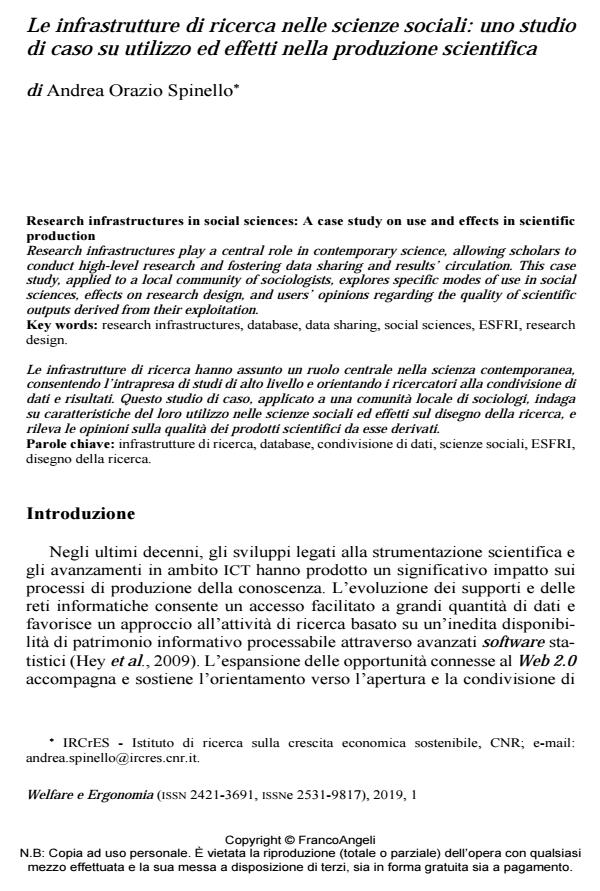Le infrastrutture di ricerca nelle scienze sociali: uno studio di caso su utilizzo ed effetti nella produzione scientifica
Titolo Rivista WELFARE E ERGONOMIA
Autori/Curatori Andrea Orazio Spinello
Anno di pubblicazione 2020 Fascicolo 2019/1 Lingua Italiano
Numero pagine 12 P. 67-78 Dimensione file 183 KB
DOI 10.3280/WE2019-001007
Il DOI è il codice a barre della proprietà intellettuale: per saperne di più
clicca qui
Qui sotto puoi vedere in anteprima la prima pagina di questo articolo.
Se questo articolo ti interessa, lo puoi acquistare (e scaricare in formato pdf) seguendo le facili indicazioni per acquistare il download credit. Acquista Download Credits per scaricare questo Articolo in formato PDF

FrancoAngeli è membro della Publishers International Linking Association, Inc (PILA)associazione indipendente e non profit per facilitare (attraverso i servizi tecnologici implementati da CrossRef.org) l’accesso degli studiosi ai contenuti digitali nelle pubblicazioni professionali e scientifiche
Le infrastrutture di ricerca hanno assunto un ruolo centrale nella scienza contemporanea, consentendo l’intrapresa di studi di alto livello e orientando i ricercatori alla condivisione di dati e risultati. Questo studio di caso, applicato a una comunità locale di sociologi, indaga su caratteristiche del loro utilizzo nelle scienze sociali ed effetti sul disegno della ricerca, e rileva le opinioni sulla qualità dei prodotti scientifici da esse derivati.;
Keywords:Infrastrutture di ricerca, database, condivisione di dati, scienze sociali, ESFRI, disegno della ricerca.
- Binz-Scharf M.C., Kalish Y. and Paik L. (2014). Making Science: New Generations of Collaborative Knowledge Production. American Behavioral Scientist, November, 1-11.
- Boulton G., Campbell P., Collins B., Elias P., Hall W., Laurie G., O’Neill O., Rawlins M., Thornton J., Vallance P. and Walport M. (2012). Science as an open enterprise. London: The Royal Society.
- Ciula A., Nyhan J. and Moulin, C. (2011). Research Infrastructures in the Digital Humanities. ESF Science Policy Briefing 42, European Science Foundation.
- Dutton W.H. and Meyer E.T. (2009). Experience with New Tools and Infrastructures of Research: An exploratory study of distance from, and attitudes toward, e-Research. Prometheus, 27(3): 223-238.
- EC - European Commission (2008). Proposal for a Council Regulation on the Community legal framework for a European Research Infrastructure (ERIC).
- EC - European Commission (2017). Interim Evaluation of the European Research Infrastructures including eInfrastructures in Horizon 2020. Report of the Expert Group.
- ESFRI (2016). Strategy Report on Research Infrastructures - Roadmap 2016. Science and Technology Facilities Council.
- ESFRI (2018). Strategy Report on Research Infrastructures - Roadmap 2018. Dipartimento di Fisica – Università degli Studi di Milano.
- Farago P. (2014). Understanding How Research Infrastructures Shape the Social Sciences: Impact, challenges, and outlook. In: Duşa A., Nelle D., Stock G. and Wagner G.G., editors, Facing the Future: European Research Infrastructures for the Humanities and Social Sciences. Berlin: SCIVERO Verlag.
- Fitzgerald R. (2016). The European Social Survey Infrastructure: Past, Present and Future, keynote session presentation at 3rd International ESS Conference, 13-15th July, University of Lausanne.
- German Council of Science and Humanities (2011). Recommendations on Research Infrastructures in Humanities and Social Sciences. WR (Wissenschaftsrat).
- Hey T., Tansley S. and Tolle K., editors (2009). The fourth paradigm. Data-intensive scientific discovery. Redmond, Washington: Microsoft Research.
- Hine C. (2006). Databases as scientific instruments and their role in the ordering of scientific work. Social Studies of Science, 36(2): 269-298.
- Hüsing T., Robinson S., Barjak F., Bendel O., Wiegand G., Eccles K., Meyer E., Schroeder R., Kertcher Z. and Coslor E. (2010). eResearch2020: The Role of e-Infrastructures in the Creation of Global Virtual Research Communities. Final Report. Report to the European Commission. Bonn and Brussels: European Communities.
- Leonelli S. (2012). When Humans Are the Exception: Cross-Species Databases at the Interface of Biological and Clinical Research. Social Studies of Science, 42(2): 214-236.
- Lossau N. (2012). An Overview of Research Infrastructures in Europe – and Recommendations to LIBER. Liber Quarterly: The Journal of European Research Libraries, 21(3/4): 313-329.
- MIUR (2010), Programma Nazionale della Ricerca 2010-2012. Glossario. -- Testo disponibile al sito: http://www.miur.it/UserFiles/3248.pdf (Ultimo accesso: febbraio 2019).
- Nielsen M. (2011). Reinventing discovery: The new era of networked science. New Jersey: Princeton University Press.
- OCSE (2013). New Data for Understanding the Human Condition. International Perspectives, OECD Global Science Forum Report on Data and Research Infrastructure for the Social Sciences, OECD.
- Renschler I., Kleiner B. and Wernli B. (2013). Concepts and key features for understanding social science research infrastructures. In: Kleiner B., Renschler I., Wernli B., Farago P. and Joye D., editors, Understanding Research Infrastructures in the Social Sciences. Zurich: Seismo Press.
- Spinello A.O. (2018). Il cambiamento nel modo di produzione della conoscenza. Un’esplorazione degli effetti delle infrastrutture di ricerca nel lavoro degli scienziati sociali. Tesi di Dottorato. Sapienza Università di Roma.
- Yin R.K. (2009). Case Study Research: Design and Methods (fourth edition). Thousand Oaks, CA: Sage.
- ce (RI-RG): Reflections on Social Inquiry and Method. S.NET Conference, Twente, Netherlands 22-25 October.
- Reale E. (2014). Governance. In: The Contribution of Science and Society (FP6) and Science in Society (FP7) to a Responsible Research and Innovation. A Review, paper prepared for the EU SiS-RRI Conference, Rome, 19-20 November 2014, CNR Ed., Roma, pp. 153-186.
- Rip A. (2003). Societal challenges for R&D evaluation. In: Shapira P. and Kuhlman S., Learning from Science and Technology Policy Evaluation. Cheltenham UK: Edward Elgar.
- Stilgoe J., Owen R. and Macnaghten P. (2013). Developing a framework for responsible innovation. Research Policy, 42: 1568-1580.
- Von Schomberg R., editor (2011). Towards Responsible Research and Innovation in the Information and Communication Technologies and Security Technologies Fields. Brussels: European Commission.
Andrea Orazio Spinello, Le infrastrutture di ricerca nelle scienze sociali: uno studio di caso su utilizzo ed effetti nella produzione scientifica in "WELFARE E ERGONOMIA" 1/2019, pp 67-78, DOI: 10.3280/WE2019-001007